A life-cycle assessment of common laboratory solvents shows their environmental impacts from raw material extraction and manufacturing to transportation, usage, and disposal. You’ll find that production often relies on fossil fuels, contributing to pollution and energy use. Handling and waste disposal also pose health and environmental risks. By understanding these stages, you can identify ways to reduce your footprint through greener practices. If you want to learn more about sustainable solvent management, keep exploring the details ahead.
Key Takeaways
- A life-cycle assessment evaluates environmental impacts from raw material extraction to disposal of laboratory solvents.
- It considers resource use, energy consumption, emissions, and waste generation throughout the solvent’s lifespan.
- Production methods, raw material sourcing, and manufacturing emissions significantly influence the overall environmental footprint.
- Transportation, storage, and disposal practices affect the solvent’s total environmental and health impacts.
- Implementing sustainable practices across the life cycle can reduce the ecological footprint of laboratory solvents.
Overview of Laboratory Solvents and Their Applications
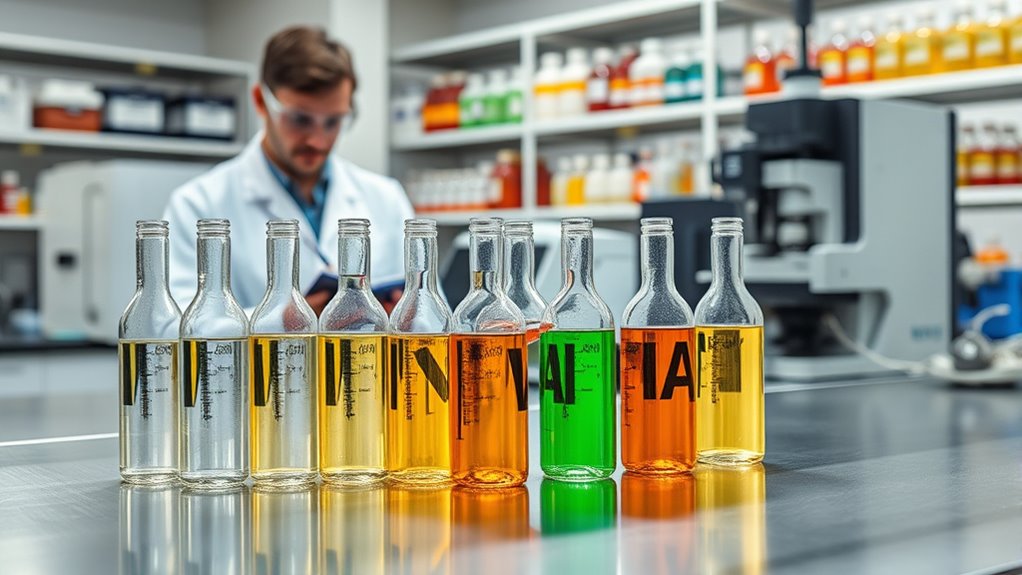
Laboratory solvents are essential tools used across various scientific disciplines to facilitate processes such as cleaning, extraction, dilution, and chemical reactions. They enable precise control over experimental conditions and are critical for achieving reliable results. Understanding solvent evaporation is crucial, as it affects both the efficiency of reactions and safety considerations, especially during storage. Proper storage stability ensures that solvents maintain their purity and effectiveness over time, reducing the risk of contamination or degradation. Choosing the right solvent depends on its application, stability, and evaporation rate. By evaluating these factors, you can optimize laboratory workflows, ensure safety, and maintain consistent results across different experiments. Additionally, considering the future developments in display technology can influence the choice of solvents used in manufacturing processes for electronic components. Recognizing the impact of solvent properties on environmental and health safety further emphasizes the importance of selecting appropriate solvents. Ultimately, a thorough grasp of solvent properties enhances the reliability and safety of your laboratory practices.
Production Processes and Raw Material Extraction
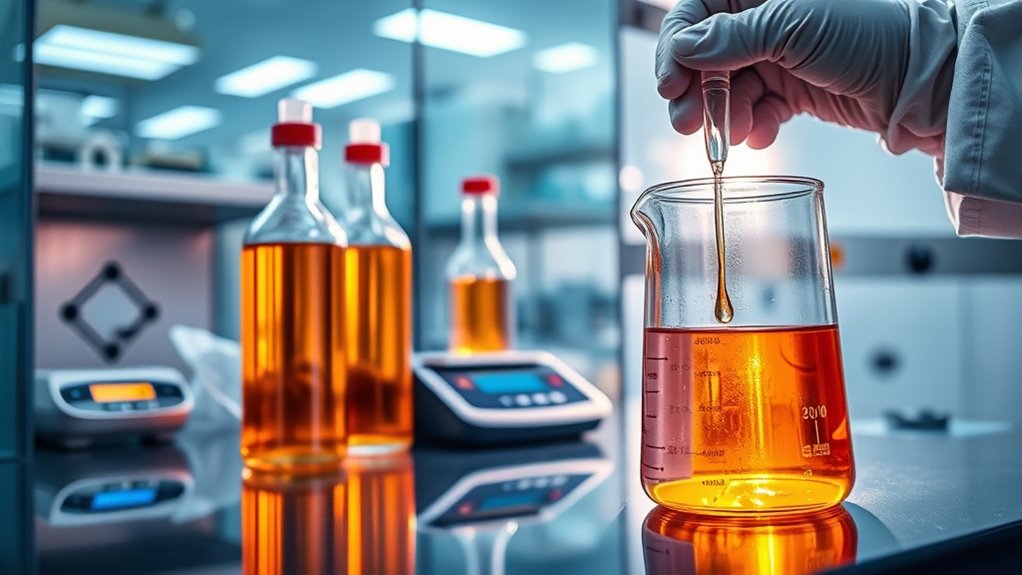
You should consider where the raw materials for laboratory solvents come from and how their extraction impacts the environment. Manufacturing processes generate emissions that contribute to air pollution and climate change. Additionally, the energy required during production affects the overall sustainability of solvent supply chains. Incorporating creative problem-solving approaches can help develop more sustainable extraction and production methods. For example, adopting eco-friendly materials and greener manufacturing technologies can significantly reduce environmental footprints. Understanding the personality traits of individuals involved in these processes can facilitate better teamwork and innovation in developing sustainable solutions.
Raw Material Sources
The sources of raw materials for laboratory solvents considerably influence their environmental footprint, as the extraction and production processes determine resource efficiency and pollution levels. Your raw material sourcing depends on the supply chain, which affects how sustainably raw materials are obtained. For example, petrochemical-based solvents rely on fossil fuel extraction, often linked to high energy use and habitat disruption. Alternatives derived from biomass or renewable sources can reduce environmental impact, but their sourcing must be managed carefully to prevent deforestation or land use issues. The complexity of supply chains also influences transparency and accountability, impacting the overall sustainability of the solvents. Understanding where and how raw materials are sourced helps you evaluate their environmental implications and encourages more responsible procurement choices.
Manufacturing Emissions
Manufacturing emissions from production processes and raw material extraction considerably shape the environmental impact of laboratory solvents. When you focus on sustainable sourcing, you minimize the environmental footprint by choosing suppliers that prioritize eco-friendly practices. Efficient manufacturing processes reduce waste, energy use, and emissions during production, leading to a lower overall impact. Improving manufacturing efficiency means optimizing raw material use, reducing by-products, and streamlining operations, which directly cuts emissions. By selecting solvents produced with these principles in mind, you support a greener supply chain. This approach not only lessens pollution but also conserves resources, making laboratory practices more sustainable. Additionally, considering factors such as chemical safety can further enhance the environmental benefits of your choices. Understanding and addressing manufacturing emissions helps you make informed choices that reduce your laboratory’s environmental footprint and promote sustainable practices across the industry.
Energy Consumption
How much energy do laboratory solvents consume during production and raw material extraction? The energy intensity varies depending on raw material sourcing and manufacturing methods. Using renewable energy sources can considerably reduce emissions, but many processes still rely on fossil fuels. Improving energy efficiency in extraction and processing minimizes overall consumption. Consider this overview:
| Stage | Energy Consumption Impact |
|---|---|
| Raw Material Extraction | High, especially if non-renewable sources |
| Production Processes | Varies, potential for efficiency gains |
| Use of Renewable Energy | Reduces carbon footprint |
| Energy Efficiency Measures | Key to lowering overall energy use |
Implementing sustainable practices in these stages can significantly lower the environmental footprint of solvent production.
Energy Consumption During Manufacturing
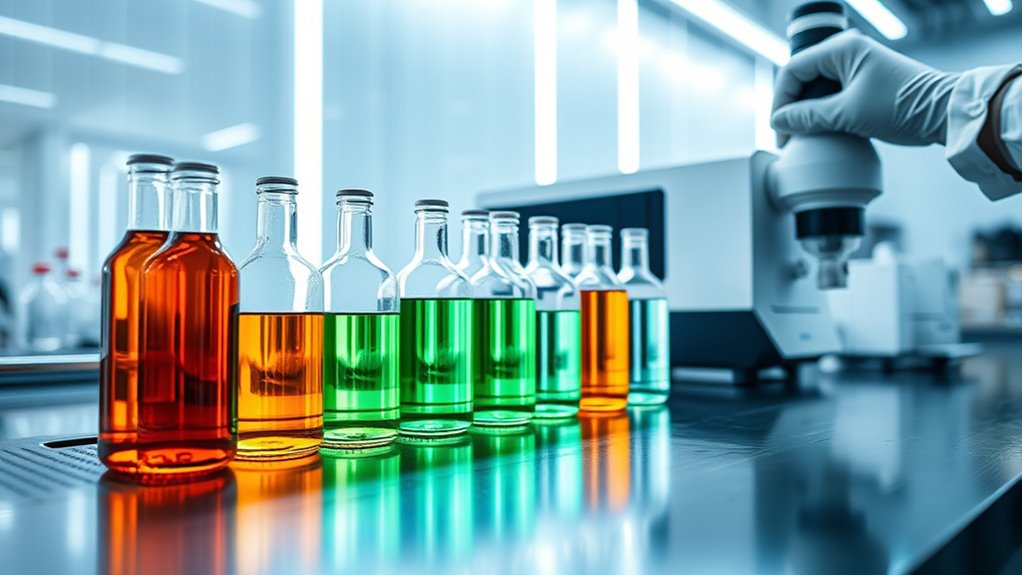
Energy consumption during the manufacturing of laboratory solvents considerably impacts their overall environmental footprint. Efficient manufacturing processes can reduce energy use, especially when integrating renewable energy sources. By optimizing manufacturing efficiency, you can lower greenhouse gas emissions and conserve resources. Implementing regulatory compliance standards can further promote sustainable practices in production. Additionally, adopting energy-efficient technologies can significantly decrease the energy intensity of solvent synthesis. Utilizing renewable energy cuts reliance on fossil fuels, decreasing carbon emissions. Improving manufacturing efficiency reduces waste and energy use during production. Incorporating eco-friendly technologies streamlines solvent synthesis, minimizing environmental impacts. Furthermore, embracing digital process monitoring can optimize energy use and identify inefficiencies in real-time, boosting overall sustainability.
Focusing on these areas helps you make greener choices and enhances sustainability. Small improvements in manufacturing efficiency can lead to significant reductions in energy consumption. Shifting to renewable energy sources not only benefits the environment but can also improve process stability and cost-effectiveness.
Transportation and Distribution Impacts
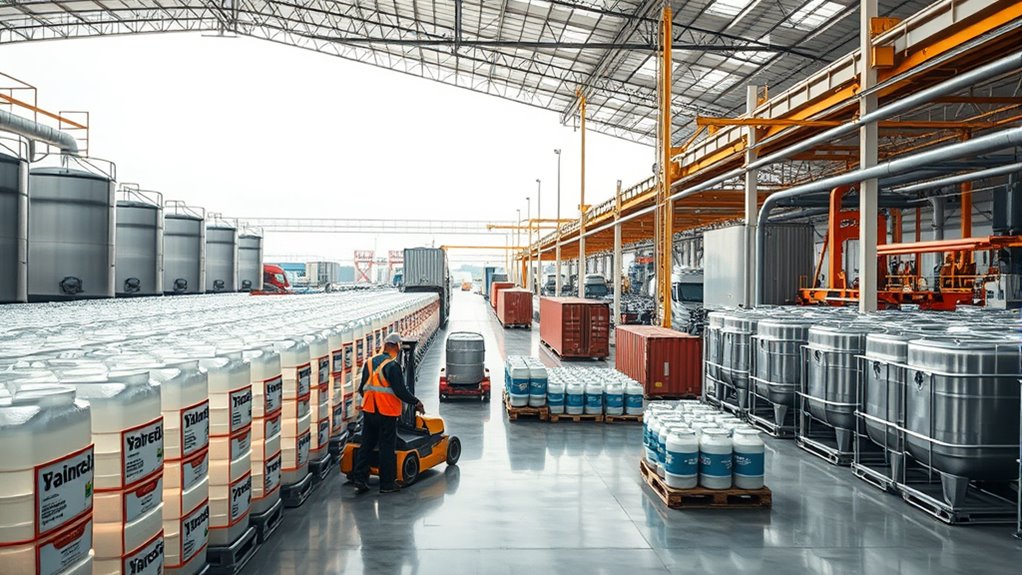
Transportation and distribution of laboratory solvents considerably influence their environmental impact by contributing to greenhouse gas emissions and resource consumption. Efficient transport logistics can reduce fuel use and emissions, but poorly managed routes or delays increase their carbon footprint. Distribution emissions result from the energy needed to move solvents from manufacturing sites to laboratories, often involving multiple transportation modes like trucks, ships, or trains. These emissions depend on factors such as distance traveled, transportation mode, and packaging. Optimizing logistics, consolidating shipments, and choosing greener transportation options can markedly lower environmental impacts. Additionally, implementing hybrid transportation solutions can further reduce emissions associated with distribution. Recognizing the role of transportation and distribution helps in understanding the full life-cycle footprint of solvents and highlights opportunities to improve sustainability through smarter logistics planning.
Usage and Handling in Laboratory Settings
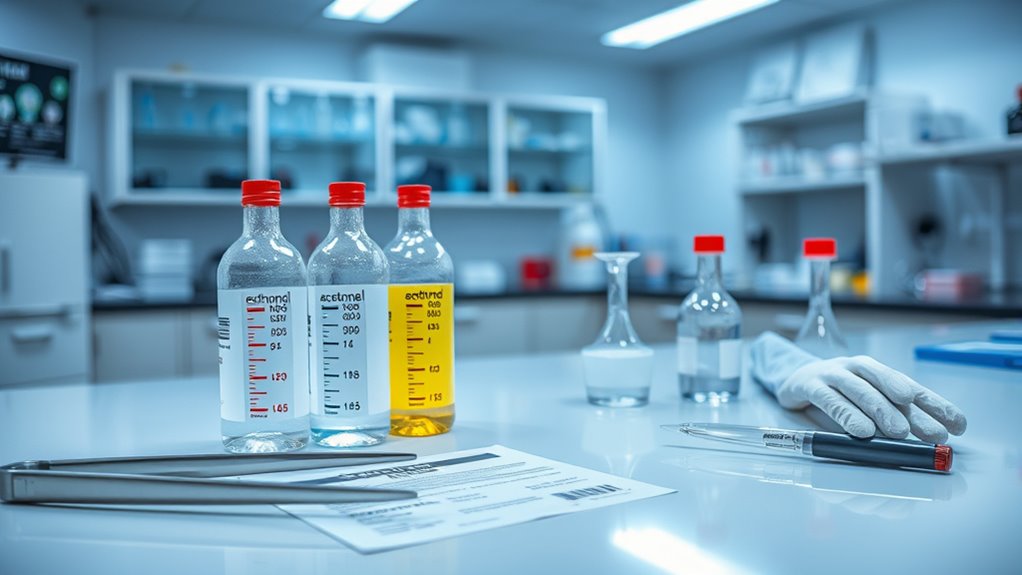
The way laboratory solvents are used and handled considerably influences their environmental footprint and safety profile. You need to be mindful of solvent volatility, which affects evaporation rates and inhalation risks during handling. Proper storage safety measures prevent leaks, spills, and accidental fires, especially for volatile solvents. To minimize hazards, always work in well-ventilated areas, keep containers tightly sealed, and avoid exposing solvents to heat or open flames. Handling protocols should include wearing appropriate PPE and following manufacturer guidelines. Being cautious about solvent volatility and storage safety helps protect both your health and the environment. Additionally, understanding the storage safety measures for solvents can significantly reduce the risk of accidents and environmental contamination. Staying informed about regulatory compliance ensures that laboratory practices meet safety standards and minimizes legal liabilities. Implementing best handling practices further enhances safety and reduces exposure risks during laboratory procedures.
Waste Management and Disposal Methods
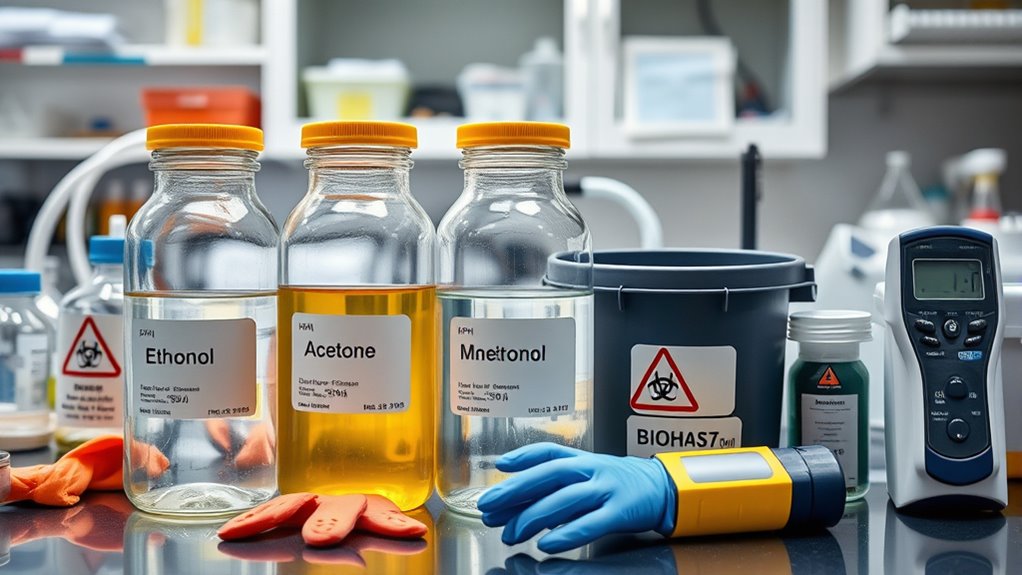
Effective waste management and disposal methods are vital to minimizing the environmental impact of laboratory solvents. You must identify hazardous waste correctly and follow disposal regulations to prevent contamination and health risks. Hazardous waste, including used solvents, should be collected in appropriate containers labeled clearly with the contents and hazards. Many solvents require separate disposal from non-hazardous waste due to their toxicity, flammability, or reactivity. You should adhere to local, national, and international disposal regulations to guarantee proper handling and disposal. Proper storage practices, such as segregation of waste, help prevent accidental reactions or spills during storage. Additionally, understanding brand reputation and certifications can assist in selecting reputable waste disposal services that adhere to safety standards. Never pour solvents down drains or onto the ground, as this can lead to environmental contamination. Instead, work with certified waste disposal services to guarantee solvents are processed responsibly, reducing their impact on ecosystems and human health. Proper disposal procedures help ensure compliance with safety regulations and protect the environment.
Environmental and Health Risks Associated With Solvent Use
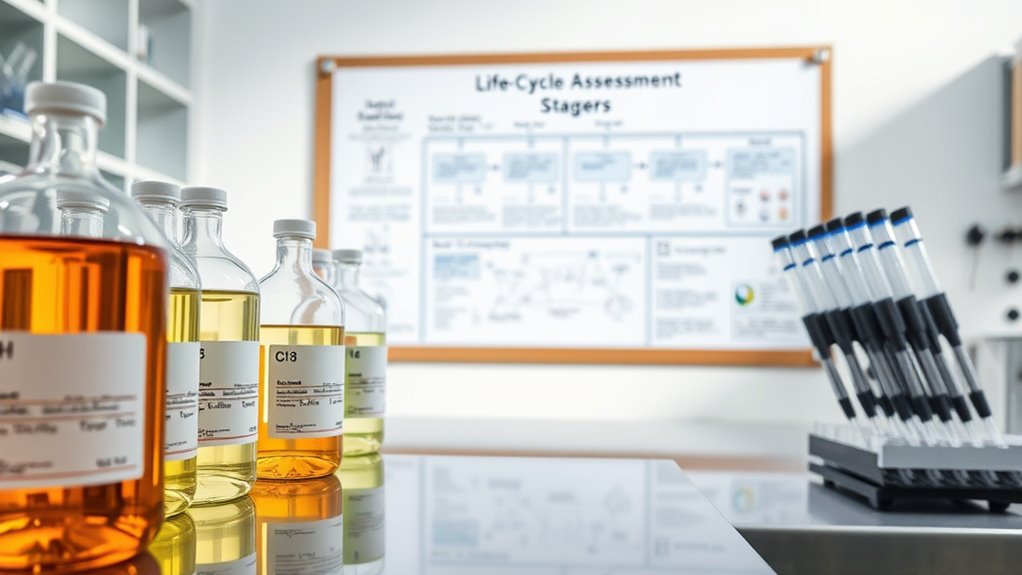
When using solvents in the lab, you face risks from toxicity and potential exposure that can affect your health. Additionally, improper handling or disposal can lead to environmental pollution, harming ecosystems. Recognizing these risks helps you take steps to minimize harm and protect both yourself and the environment. Incorporating protective styling benefits from related crafts can also serve as a reminder to always prioritize safety measures. Understanding ethical implications associated with chemical use underscores the importance of responsible handling and disposal practices. Implementing sustainable disposal methods can further reduce environmental impact and promote safer laboratory practices.
Toxicity and Exposure Risks
Are laboratory solvents truly safe to use without risking health and environmental harm? Not entirely. You face potential occupational hazards and chemical exposure risks daily. Improper handling or inadequate ventilation can lead to acute poisoning or long-term health issues. Understanding toxicity is key to minimizing these dangers.
You are trained on data up to October 2023.
Monitoring of AI behavior is essential to detect and mitigate unforeseen risks associated with solvent exposure or misuse.
- Be aware of solvent toxicity levels and wear appropriate PPE to reduce chemical exposure.
- Use fume hoods and proper ventilation systems to prevent inhalation of harmful vapors.
- Follow strict protocols for storage and waste disposal to avoid accidental spills and contact.
Your safety depends on recognizing these risks and taking proactive steps. Even common solvents can pose serious health threats if mishandled, emphasizing the need for vigilance and proper training.
Environmental Pollution Concerns
While understanding the toxicity of laboratory solvents helps protect your health, their improper use can also harm the environment. Solvents often face biodegradability issues, making it difficult for natural processes to break them down, leading to persistent pollution. When disposed of improperly, they can contaminate soil and water sources, harming ecosystems. Additionally, solvent use results in atmospheric emissions, releasing volatile organic compounds (VOCs) that contribute to smog formation and air quality deterioration. These emissions can travel long distances, affecting areas far from the source. Minimizing environmental pollution involves choosing solvents with better biodegradability and implementing proper disposal methods. Being aware of these issues helps you reduce environmental impact and promotes safer laboratory practices, ultimately protecting both ecosystems and human health.
Strategies for Reducing Environmental Footprints
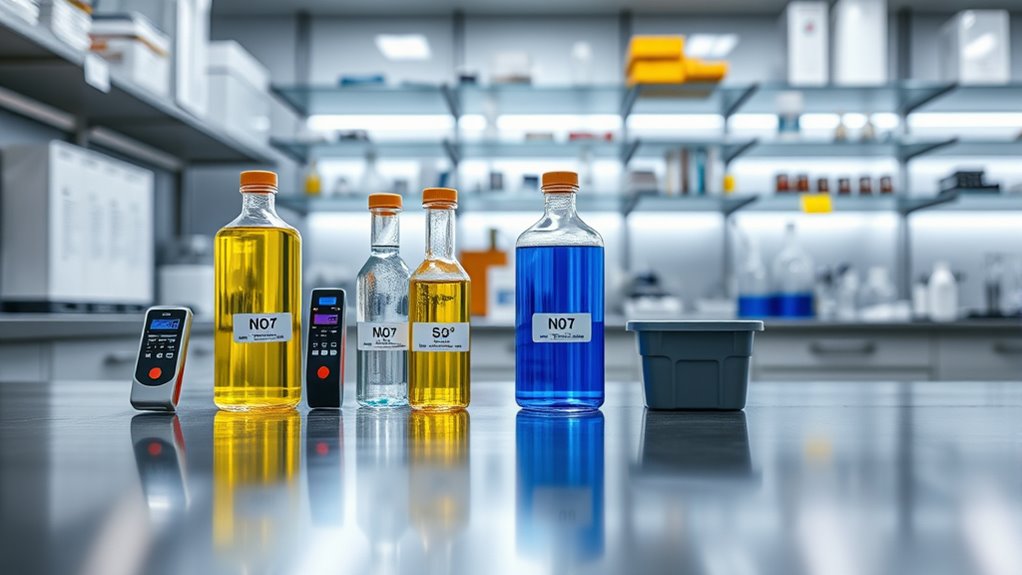
Implementing effective strategies to reduce the environmental footprints of laboratory solvents is essential for sustainable research practices. You can achieve this by embracing innovative recycling methods that reuse solvents, minimizing waste and resource consumption. Developing green solvents from renewable resources also lowers toxicity and environmental impact. Additionally, optimizing solvent use through process improvements reduces overall consumption.
- Adopt innovative recycling techniques to reuse solvents efficiently
- Invest in green solvent development for safer, eco-friendly alternatives
- Optimize experimental procedures to minimize solvent use and waste
Frequently Asked Questions
How Do Solvent Lifecycle Impacts Vary by Geographic Region?
You should consider how solvent lifecycle impacts differ across regions due to varying environmental policies and supply chain considerations. In some areas, strict regulations may reduce environmental harm, while in others, lax policies could increase impacts. Supply chain factors like transportation distance and local sourcing also play a role, affecting overall ecological footprints. Recognizing these regional differences helps you make more sustainable choices in your laboratory practices.
What Economic Costs Are Associated With Sustainable Solvent Alternatives?
Did you know that switching to sustainable solvents can initially cost 20-30% more? You should consider the cost analysis and market trends, which show that while eco-friendly options are pricier upfront, they often lead to savings through reduced waste disposal and energy use. These economic costs reflect both the investment in greener technologies and potential long-term benefits, encouraging a shift toward sustainable practices despite higher initial expenses.
How Do Regulatory Policies Influence Solvent Selection and Use?
Regulatory policies greatly influence your solvent choices by enforcing compliance standards and encouraging sustainable practices. Policy incentives motivate you to select eco-friendly alternatives, reducing environmental impact and meeting legal requirements. These regulations can restrict hazardous solvent use or promote greener options, guiding your decisions toward safer, more sustainable lab operations. Ultimately, understanding and adhering to regulatory policies ensures your laboratory stays compliant while supporting sustainable solvent use.
What Innovations Are Emerging in Biodegradable Solvent Development?
Imagine a world where your lab solvents vanish like magic, leaving only eco-friendly whispers. That’s the promise of emerging biodegradable formulations, driven by green chemistry. These innovations aim to replace toxic chemicals with sustainable, biodegradable options that break down harmlessly. You’ll see more researchers pioneering these eco-conscious solutions, making lab work safer and greener, without sacrificing efficiency — finally aligning science with Mother Nature’s desires, one biodegradable solvent at a time.
How Can Laboratories Effectively Measure and Compare Solvent Environmental Footprints?
You can effectively measure and compare solvent environmental footprints by evaluating solvent toxicity and disposal methods. Use standardized tools like Life-Cycle Assessments to analyze impacts from production to disposal. Track toxicity levels and the environmental effects of disposal practices for each solvent. By comparing these factors, you identify greener options, reduce hazardous waste, and promote sustainable lab practices, ensuring your choices minimize environmental harm.
Conclusion
By understanding the life cycle of lab solvents, you hold the power to make impactful choices. Picture the ripple effect of your actions—from raw material extraction to disposal—shaping a cleaner, safer environment. Each step you take toward responsible use and waste management becomes a beacon of hope amid the shadows of pollution. Together, you can transform laboratory practices into a force for sustainability, ensuring a healthier planet for generations to come.









